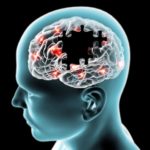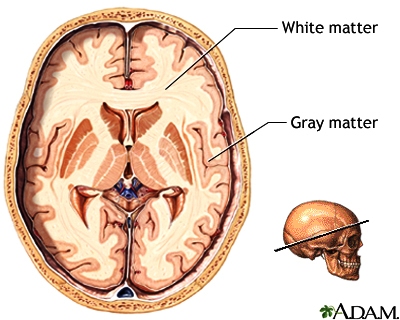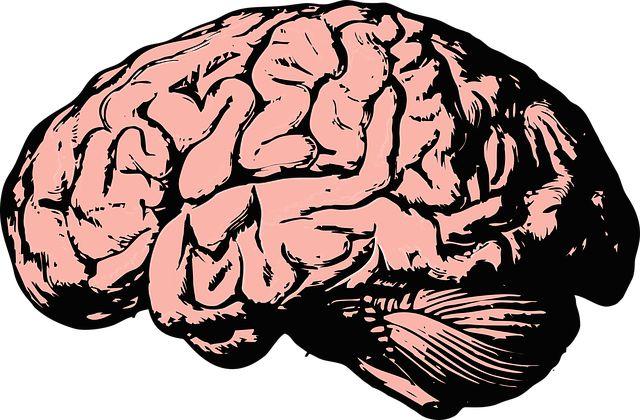White Matter Disease
White matter Disease is the largest and the deepest part of the brain which connects various parts of the brain with each other and the superficial regions of the spinal cord.
Join nirogitan Facebook group: Nirogitan

This tissue consisting of numerous nerve fibers surrounded by a white substrate-myelin, because of which it appears white. The white matter helps in faster coordination between different regions of the brain and spinal cord. So any changes in this tissue may cause disturbances in walking, learning, thinking and balancing. The myelin with acts as electrical insulation to the axons, or nerve fibers are damaged, and the nerve impulses are not transmitted properly, so the function of the specific part of the brain is not carried out. This condition is known as the white matter disease or leukoaraiosis or white matter hyperintensities.
WMD – Abbreviation
White Matter disease is the full form of WMD
Other terms for WMD
WMI – White Matter Injury
WML – White Matter Lesion
WMD, Age-related progressive disease
As the age increases this disease progresses and gets worse gradually. It results in cognitive declines in functionality and dementia in older patients. Nearly half of the population in their 60’s have this degeneration of the white matter. This may cause stroke, which is due to lack of blood flow which damages the parts of the brain. Sometimes over time, tiny symptomless strokes which neither the patient nor the doctor notices until it progressively accumulates over the years to cause dementia. These kind of stroke show no disturbances in vision, speech, and language with weakness, which are all the signs of stroke. So, if you have anyone in old age at your home you must consult with the doctor even though they have only minor losses in the brain functions.
White Matter Disease vs Gray Matter Disease

Likewise the white matter, the gray matter also contains numerous networks of neurons. Any loss in the neurons of the gray matter results in neurodegenerative disease. Though, white matter damages are seen in these diseases physiological hallmarks are located in the gray matter. Dementias like Alzheimer’s disease and frontotemporal dementia are neurodegenerative diseases. The loss of motor activities in Parkinson’s disease is directly related to the loss of neurons that produce the neurotransmitter – dopamine in the substantia nigra located in the gray matter. So, one must have a wide knowledge of both white and gray matter to come to a differential diagnosis.
Don’t Miss: Ovarian Cyst Pain
Causes of WMD
Disease Causes
This disease is more prone to older people. Many diseases, injuries or toxins may cause white matter degeneration at their later stages including,
- Diabetes
- Parkinsonism
- History of Stroke
Diabetes and WMD
Diabetes is seemed to be associated with progressive regional metabolism and microcirculation. It may affect the blood flow to the brain and accelerates white matter degeneration. As a microvascular disease in type two diabetes mellitus, the abnormalities in the white matter are responsible for reduced flow of blood to the main parts of the brain, increased resistance in the vessels supplying greater parts of the brain and inflammation in the blood vessels.
Parkinson’s Disease and WMD
Patients with Parkinson’s disease develop age-related white matter diseases. The abnormalities of white matter disease overlap with the features of Parkinson’s disease. WMD in Parkinson”s may contribute to decreased motor functions, in particular, balance issues and cognitive abnormalities.
Stroke and WMD
In worldwide stroke is the major cause of disabilities and deaths. It is well known that ischemic stroke ( stroke due to decreased blood flow to the brain) causes injury to the grey matter. However, white matter lesions may also be poor outcomes of stroke. The white matter is exquisitely more vulnerable to ischemia ( reduction in blood flow) and is severely damaged more than the gray matter. Infarction in the small peripheral blood vessels supplying the white matter causes injury to the white matter. And, any blockage in the intracranial arteries which supply the grey and white matter profoundly injuries the white matter.
Know major risk factors
Major risk factors are,
- High blood pressure
- High cholesterol levels
- Vascular or blood vessel inflammation
- Cigarette smoking
- Heart problems
- Stroke
Blood vessel problems are major risk factors. This lead to heart diseases or stroke, which cause damage or lesion to the white matter causing white matter disease.
What are the signs and symptoms?
The symptoms are progressive and the severity of the disease increases over time. You may not even notice something is happening until it reaches the advanced level.
The following are the symptoms,
- Difficulty in problem-solving and learning
- Decreased ability to think
- Unusual mood swings
- Loss of coordination in day to day activities
- Depression
- Balancing while standing or walking becomes difficult, so the patient falls often
- Ability to control urine outflow, resulting in urine leakage and pain during urination.
- Will be unable to multitask, can perform only one work at a time
- Slow walking
Sometimes these symptoms will be very mild in the patients and they may have unnoticeable strokes as I have mentioned earlier. So, it is good to get diagnosed earlier.
Ways of diagnosis

With the advancement in medical technology, it has become easier to point out white matter disease. The diagnosis is based on the symptoms and imaging tests. Additional tests have to be performed for ruling out other diseases. MRI (Magnetic resonance imaging) scans your brain and picture it. You will be asked to take a specific MRI scan called the T2 flair. This type of MRI gives a detailed view of the white matter of the brain and detects the abnormalities. The area of the lesion appears as brighter spots than normal regions. These hyperintense areas ( bright white regions) on the MRI are the damaged white matter. Your cardiovascular opinion also plays an important role in the diagnosis. The clinician comes to a final diagnosis with your MRI, other symptoms and cardiovascular health.
White Matter lesions in Multiple Sclerosis

MS is an immune-mediated inflammatory disease. In multiple sclerosis, the white fatty myelin coating surrounding axon is destroyed in multiple sclerosis. This resulting nerve fiber damage leads to disrupted communication with the brain and the various parts of the body. The white matter substances of the brain and the spinal cord are affected. Multiple sclerosis lesions, known as plaques, may form in brain white matter anywhere. The progressive lesion formation in multiple sclerosis often leads to physical disability and cognitive decline. Magnetic resonance imaging (MRI) of the brain is useful in the diagnosis and treatment of multiple sclerosis
Resulting complications
There is a study that says that white matter disease is responsible for every 5th stroke worldwide. It brings damage to the cognitive areas of the brain and causes difficulty in planning, organizing, attention, balancing and so on.
There is even evidence that white matter disease some times causes dementia.
What is the treatment?
There is no specific treatment for white matter disease. The primary treatment is to improve your physical health, it may help with your balancing and walking problems. With little or no assistance, you will develop confidence and boosts your overall physical and mental health.
Managing your cardiovascular health also proves to slow the progression of the disease and its symptoms. You must take care of blood pressure, the physician always prescribes blood pressure regulating tablets to the diagnosed patients. Make sure you take it regularly. Smoking, which may lead to small blood vessel problems is strict to be avoided.
For diabetics
As discussed earlier, in diabetes the blood flow to the brain decreases. So, enhancing the blood circulation to the brain may help in reducing or preventing cerebrovascular complications in them.
For Parkinson’s
Early prevention or reducing the severity of white matter damage by reducing cerebrovascular risk factors such as high blood pressure – hypertension, Diabetes, abnormal cholesterol or fats ( lipid) level in blood-dyslipidemia, obesity, alcohol, smoking, etc. It is possible to reduce the reduced motor and cognitive abnormalities in Parkinson’s patients
For stroke
White matter injuries are more frequent and common in stroke patients than in normal individuals. As of stroke, particularly ischemic stroke causes reduced blood flow to the brain may result in white matter disease. All treatments targeting white matter disease are limited to pre-clinical animal studies, there is no specific treatment for human WMD during ischemic stroke. Risk factor management is one proven treatment for white matter diseases.
Other potential Treatments
Potential treatments for white matter disease include,
- Risk factor management
- Thrombolytic therapy
- Cell therapy
- Stimulations of oligodendrogenesis and axonal plasticity
Conclusion
Prevention is always better than searching for a cure. There are many kinds of research going on to understand the causes effects and treatment of white matter disease. With all recent advancements in future researchers may completely understand this disease and find the treatment ways. Though there is no specific treatment there are ways to late or control the symptoms. Discuss with a doctor in case you or any of your family member is experiencing the symptoms. Keep your blood sugar and blood pressure under control. Have a habit of regular moderate workout to stay healthy. Follow a low cholesterol and sodium diet. Right away stop any type of substance abuse such as cigarette smoking, drinking alcohol, taking drugs. Do a full-body check-up every year, early it’s diagnosed you can stay with your loved one, the more years.
Sharing is Caring

I am Kumudhavarshini. A medical student from Chennai. I am currently doing my MBBS degree. I completed my schoolings in 2018. Right now I am in my second year. I completed my first year with 88%. I am not a topper but definitely a good above-average student at my college. I wanted to be a research journalist from the starting but I ended up in the medical field. But joining College, going to the hospital daily I got to know one thing that I can even outshine in this field and made myself clear to become a world’s leading Neurosurgeon


